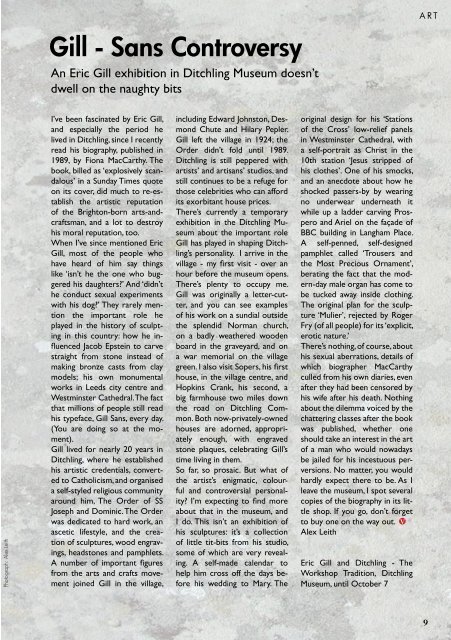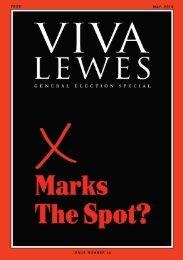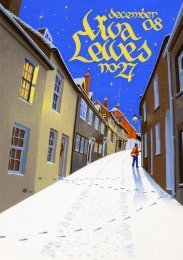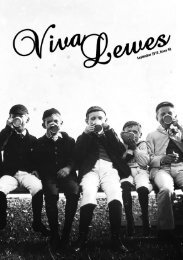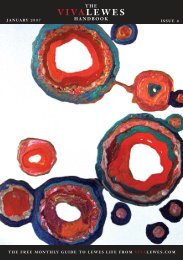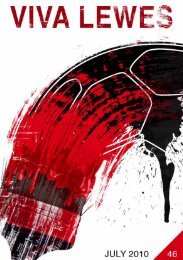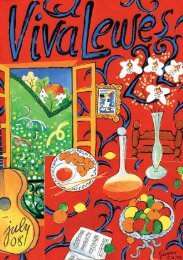You also want an ePaper? Increase the reach of your titles
YUMPU automatically turns print PDFs into web optimized ePapers that Google loves.
Photograph: Alex Leith<br />
Gill - Sans Controversy<br />
An Eric Gill exhibition in Ditchling Museum doesn’t<br />
dwell on the naughty bits<br />
I’ve been fascinated by Eric Gill,<br />
and especially the period he<br />
lived in Ditchling, since I recently<br />
read his biography, published in<br />
1989, by Fiona MacCarthy. The<br />
book, billed as ‘explosively scandalous’<br />
in a Sunday Times quote<br />
on its cover, did much to re-establish<br />
the artistic reputation<br />
of the Brighton-born arts-andcraftsman,<br />
and a lot to destroy<br />
his moral reputation, too.<br />
When I’ve since mentioned Eric<br />
Gill, most of the people who<br />
have heard of him say things<br />
like ‘isn’t he the one who buggered<br />
his daughters?’ And ‘didn’t<br />
he conduct sexual experiments<br />
with his dog?’ They rarely mention<br />
the important role he<br />
played in the history of sculpting<br />
in this country: how he influenced<br />
Jacob Epstein to carve<br />
straight from stone instead of<br />
making bronze casts from clay<br />
models; his own monumental<br />
works in Leeds city centre and<br />
Westminster Cathedral. The fact<br />
that millions of people still read<br />
his typeface, Gill Sans, every day.<br />
(You are doing so at the moment).<br />
Gill lived for nearly 20 years in<br />
Ditchling, where he established<br />
his artistic credentials, converted<br />
to Catholicism, and organised<br />
a self-styled religious community<br />
around him, The Order of SS<br />
Joseph and Dominic. The Order<br />
was dedicated to hard work, an<br />
ascetic lifestyle, and the creation<br />
of sculptures, wood engravings,<br />
headstones and pamphlets.<br />
A number of important figures<br />
from the arts and crafts movement<br />
joined Gill in the village,<br />
including Edward Johnston, Desmond<br />
Chute and Hilary Pepler.<br />
Gill left the village in 1924; the<br />
Order didn’t fold until 1989.<br />
Ditchling is still peppered with<br />
artists’ and artisans’ studios, and<br />
still continues to be a refuge for<br />
those celebrities who can afford<br />
its exorbitant house prices.<br />
There’s currently a temporary<br />
exhibition in the Ditchling Museum<br />
about the important role<br />
Gill has played in shaping Ditchling’s<br />
personality. I arrive in the<br />
village - my first visit - over an<br />
hour before the museum opens.<br />
There’s plenty to occupy me.<br />
Gill was originally a letter-cutter,<br />
and you can see examples<br />
of his work on a sundial outside<br />
the splendid Norman church,<br />
on a badly weathered wooden<br />
board in the graveyard, and on<br />
a war memorial on the village<br />
green. I also visit Sopers, his first<br />
house, in the village centre, and<br />
Hopkins Crank, his second, a<br />
big farmhouse two miles down<br />
the road on Ditchling Common.<br />
Both now-privately-owned<br />
houses are adorned, appropriately<br />
enough, with engraved<br />
stone plaques, celebrating Gill’s<br />
time living in them.<br />
So far, so prosaic. But what of<br />
the artist’s enigmatic, colourful<br />
and controversial personality?<br />
I’m expecting to find more<br />
about that in the museum, and<br />
I do. This isn’t an exhibition of<br />
his sculptures: it’s a collection<br />
of little tit-bits from his studio,<br />
some of which are very revealing.<br />
A self-made calendar to<br />
help him cross off the days before<br />
his wedding to Mary. The<br />
original design for his ‘Stations<br />
of the Cross’ low-relief panels<br />
in Westminster Cathedral, with<br />
a self-portrait as Christ in the<br />
10th station ‘Jesus stripped of<br />
his clothes’. One of his smocks,<br />
and an anecdote about how he<br />
shocked passers-by by wearing<br />
no underwear underneath it<br />
while up a ladder carving Prospero<br />
and Ariel on the façade of<br />
BBC building in Langham Place.<br />
A self-penned, self-designed<br />
pamphlet called ‘Trousers and<br />
the Most Precious Ornament’,<br />
berating the fact that the modern-day<br />
male organ has come to<br />
be tucked away inside clothing.<br />
The original plan for the sculpture<br />
‘Mulier’, rejected by Roger<br />
Fry (of all people) for its ‘explicit,<br />
erotic nature.’<br />
There’s nothing, of course, about<br />
his sexual aberrations, details of<br />
which biographer MacCarthy<br />
culled from his own diaries, even<br />
after they had been censored by<br />
his wife after his death. Nothing<br />
about the dilemma voiced by the<br />
chattering classes after the book<br />
was published, whether one<br />
should take an interest in the art<br />
of a man who would nowadays<br />
be jailed for his incestuous perversions.<br />
No matter, you would<br />
hardly expect there to be. As I<br />
leave the museum, I spot several<br />
copies of the biography in its little<br />
shop. If you go, don’t forget<br />
to buy one on the way out. V<br />
Alex Leith<br />
Eric Gill and Ditchling - The<br />
Workshop Tradition, Ditchling<br />
Museum, until October 7<br />
a r t<br />
9


